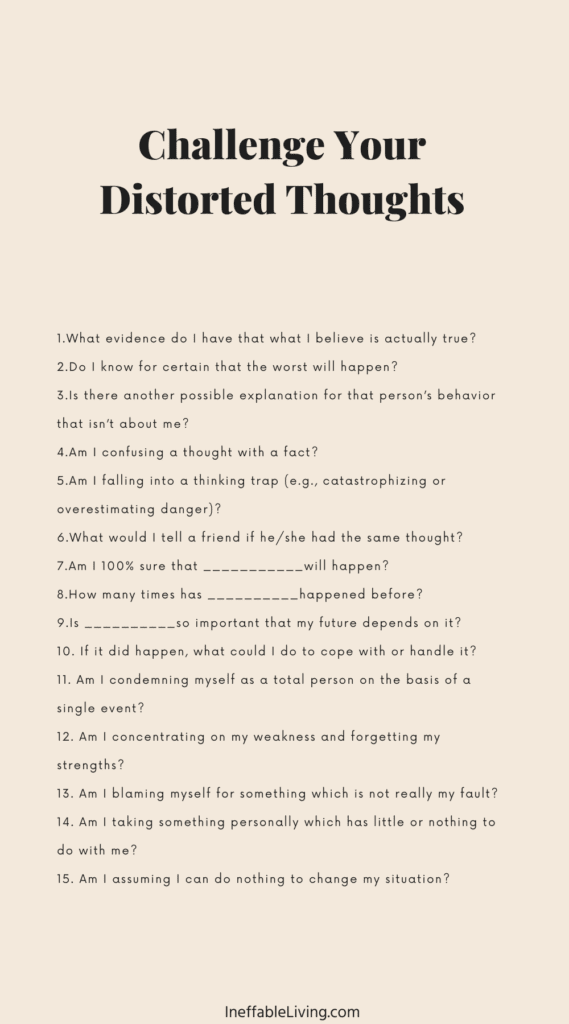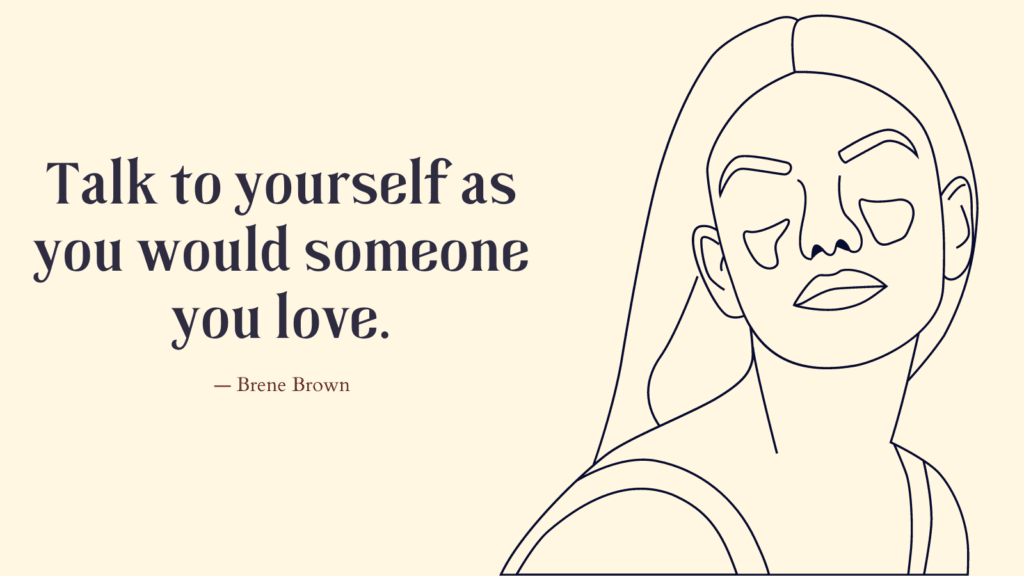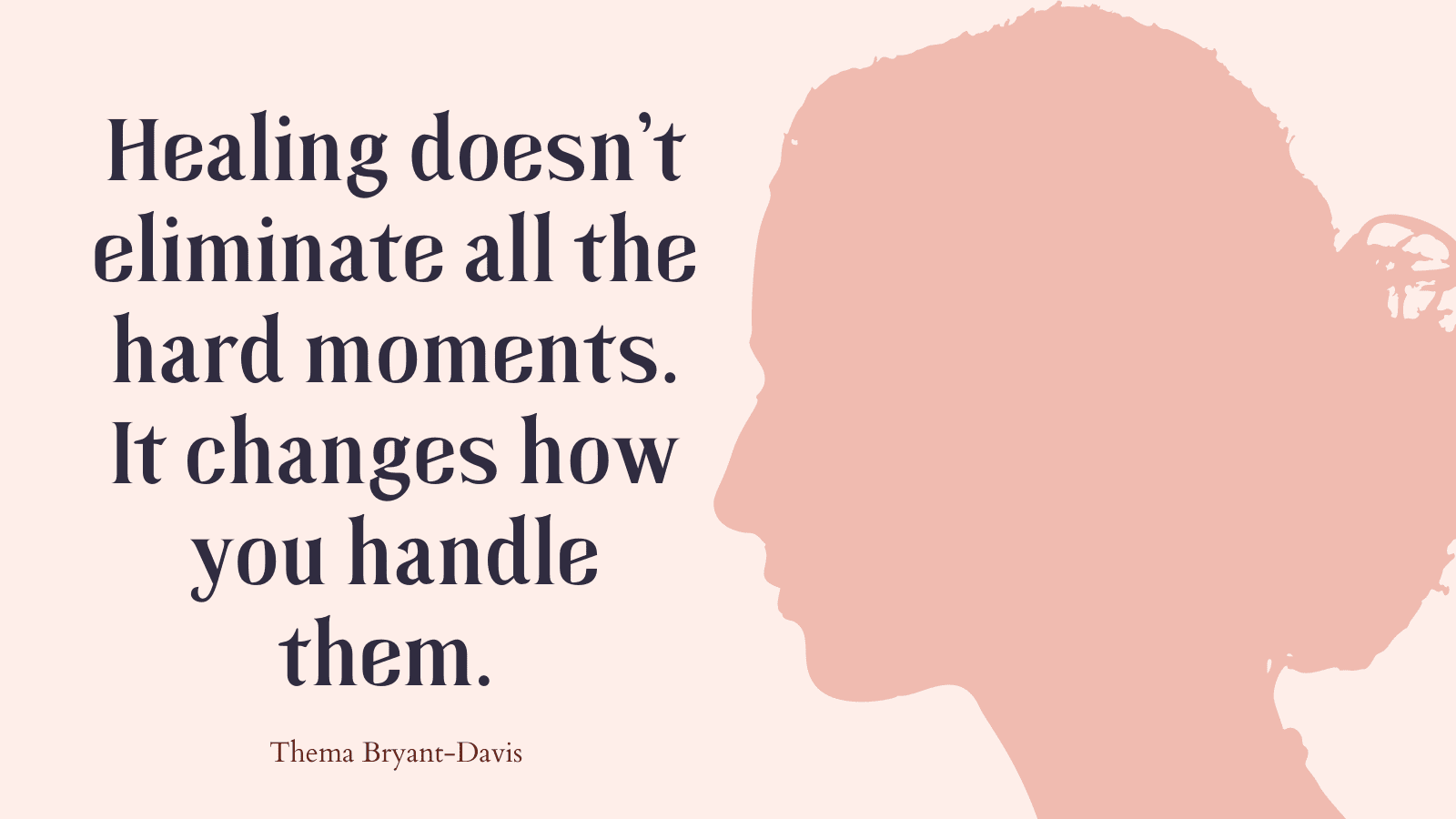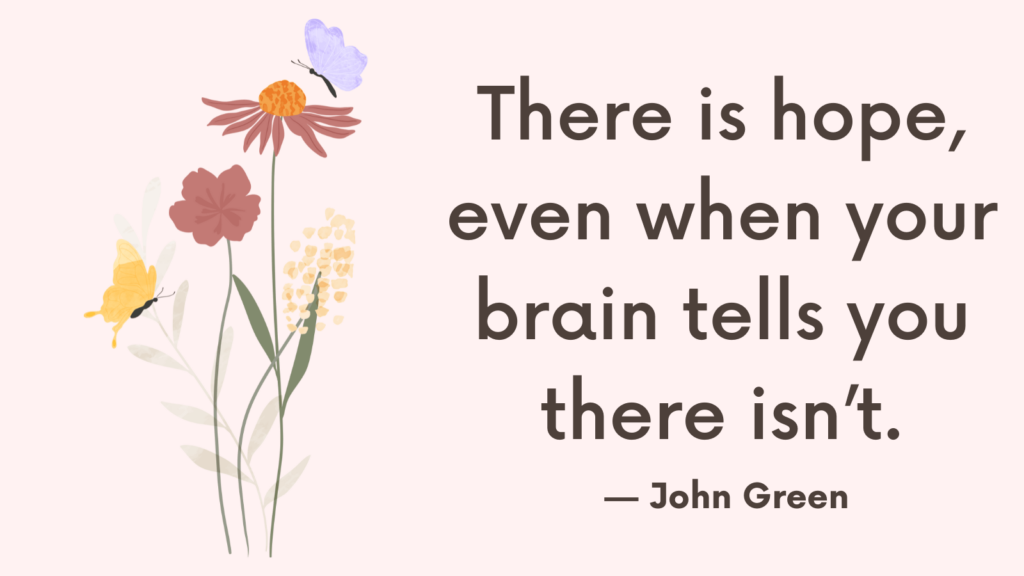This post contains negative core beliefs list and effective tips to help you challenges those beliefs.
In 2005, the National Science Foundation published an article summarizing research on human thoughts. It was found that the average person has about 12,000 to 60,000 thoughts per day. 80% of these thoughts are negative and 95% are repetitive thoughts day after day, year after year, and decade after decade.
This means that today’s thoughts are not new to you and that we are not really thinking – we just habitually repeat the mental activity. Therefore, the patterns in our lives remain the same.
Fortunately, there are ways out of these vicious cycles.
What is a Belief System?
A belief system is the sum of thoughts you think repeatedly and experience as true – it is the sum of thoughts that have joined with emotions.
You belief system is reflected back to you. You experience it daily, which only reinforces it and leads you to believe that it must be true.
For example, if you believe that “Life is a struggle,” you’ll become alert to any experiences that confirm your belief. As you notice these struggles, your belief becomes even more reinforced. You believe it’s true.
However, if you’re to believe that “Life is full of overcoming,” you’ll begin to notice experiences that confirm this belief, which reinforces it.
Most of our core beliefs begin in our childhood.
A child has one goal to focus on: how to survive. Safety and approval are essential to our survival. So, most of our core beliefs are concerned with both.
Beliefs also form in adulthood. Traumatic events can form new limiting beliefs at any age. But are easier to spot and thus change.
Our thoughts, feelings, and, actions then become heavily influenced by these subconscious beliefs.
For example, if you have a belief that you are not lovable, then no matter how many people tell you they love you, you’ll filter your experience through this belief system and feel unlovable.
Moreover, this belief acts like a magnet, drawing situations into your daily life that reinforce and “prove” you’re not lovable. You may find yourself getting into unhealthy relationships with people who are not available or people who abandon you, which only reinforces your negative beliefs about yourself.
Related: How To Stop Self-Critical Thoughts Using These Top 10 Techniques
Negative Core Beliefs List
- I am a disappointment.
- I am a failure.
- I am a loser.
- I am a mess.
- I am a mistake.
- I am awkward.
- I am bad.
- I am defective.
- I am disposable.
- I am fat.
- I am flawed.
- I am hopeless.
- I am incapable.
- I am inferior.
- I am stupid.
- I am ugly.
- I am unattractive.
- I am uninteresting.
- I am unlovable.
- I am unwanted.
- I am unworthy.
- I am useless.
- I don’t deserve anything.
- No one can be trusted.
- There’s not enough to go around.
- There’s something wrong with me.
Negative Core Beliefs List PDF
3 Views of Life
1. Life happens to me
This view comes from a low level of awareness. It leaves you feeling powerless and makes you a victim of life’s circumstances.
2. Life happens by me
At this level of awareness, you begin to recognize that you have an effect on what happens to you through your thoughts and intention.
You begin to realize that your thoughts are in line with what happens in your life, be it negative or positive.
This is when you take responsibility for your thoughts and feelings.
3. Life happens through me
As you grow even more aware, you allow yourself to accept what is, which means that you don’t fight against life.
You begin to recognize that most of your suffering comes from not accepting what comes your way and fighting against the flow of life.
For example, if someone has been diagnosed with chronic pain, rather than fighting the diagnosis and pitying themselves, they can choose to accept what is and direct their energy and time toward taking effective action moving forward.
Related: Top 10 Ways To Stop Wallowing In Self Pity
New Hope for Change
Up until the 1960s, it was believed that the brain developed during childhood and that by early adulthood its physical structure was permanent.
But recent findings in neuroscience and psychology have shown that real change can occur. The brain continues to develop and adjust throughout a person’s lifetime, creating new neural pathways and altering existing ones. This newly discovered ability is called “brain plasticity” or “neuroplasticity.”
According to B. Kolb, Robbin, & Robinson (2003, 1), “Although the brain was once seen as a rather static organ, it is now clear that the organization of brain circuitry is constantly changing as a function of experience.”
This is not to say that change is easy, but to give new hope for change. (*)
Related: Top 10 Signs Of Toxic Shame In A Person (+Best 20 Healing Shame Exercises)
How to Identify Negative Core Beliefs?
#1. Find out What You Value Most
Understanding your personality style and what you value can help you identify your core beliefs.
Personality falls along a continuum of sociotropy and autonomy.
People with a sociotropic personality value interpersonal relationships most. That means they need to feel like, accepted, and desired.
In contrast, people with an autonomous personality value achievement, competence, and independence.
Where we sit on this continuum can shift over time.
What’s your personality style?
To determine your personality type, read through the following statements and see how many of them you relate to:
If you are socially oriented:
- Being approved of feels better to you than accomplishing a task.
- You believe it’s more important to be viewed as kind than smart.
- You care about what other people think of you.
- You prioritize friends and family over work.
- Your goals are influenced by others.
- Your self-worth comes from social success.
People with sociotropic personality may experience the following negative beliefs:
- I am awkward.
- I am bad.
- I don’t fit in anywhere
- Nobody values me
- Nobody cares about me
- People who say nice things to me don’t mean them
- I am disposable.
- I am flawed.
- I am hopeless.
- I am inferior.
- I am stupid.
- I am unattractive.
- I am uninteresting.
- I am unlovable.
- I am unwanted.
- I am unworthy.
- No one can be trusted.
If you are achievement oriented:
- Your self-worth comes from your performance and achievements.
- You believe it’s more important to be considered capable or smart than nice or friendly.
- You place more importance on working hard than your social life.
- You thrive on competition.
- You usually don’t make decisions with people’s opinion in mind.
- You enjoy what you’re doing even when no one does it with you.
People with autonomous personality may experience the following negative beliefs.
- I am a disappointment.
- I am a failure.
- I am a loser.
- I am a mess.
- I am a mistake.
- I am incapable.
- I am useless.
- I am helpless
- I am unsuccessful
- I can’t control anything
- I can’t achieve
- I can’t change
- I will fail
- I am defective.
- I always get it wrong
- Everything I do goes wrong
- There’s something wrong with me.
#2. Examine Patterns in Your Life
Patterns in your life are a great way to uncover your belief systems.
For example, if you’ve always dated the same type of man, then it’s easy to figure out the qualities that seem to attract you to these men and its underlying beliefs.
Try to write down the qualities your former partners had. It’s not a coincidence that they have similarities. It’s your beliefs that determine whom you attract into your life.
Even if you go to great lengths to make sure your partner is different, you may later discover that he has the same qualities your former partners have, or you may not feel that “chemistry” with him.
Related: Inner Teenager Healing: 14 Proven Exercises to Heal Your Inner Teenager
#3. Notice When You Feel Like a Child
Another way to uncover limiting beliefs is when you feel like a child, overwhelmed by something an adult should be able to handle.
For example, you may find yourself caught in a panic attack because a friend is upset with you. You fear he may abandon you, and despite consciously reasoning that people can get upset without abandoning you, you can’t seem to calm down.
When you’re caught in a strong emotion that doesn’t seem reasonable, then this is a sign a subconscious belief system is activated.
Related: Best 15 Inner Child Exercises: How To Connect With Your Inner Child (& Heal Your Childhood Wounds)
#4. Notice When You React Rather Than Respond
Similar to the previous item, when your behavior comes from a subconscious belief, you react without conscious thinking rather than responding.
Responding to a situation comes from your adult beliefs and conscious thinking. Reacting, on the other hand, comes from childhood beliefs and thinking. It’s as though you have no control over your reaction.
If you find yourself unable to stop the loop of your judgmental thoughts or calm down your overwhelming emotions and think about how you should respond, then that’s a sign of limiting beliefs.
#5. Consider These Common Limiting Beliefs
The main reason why we hold onto old beliefs is that they helped us. Originally, they were a solution to a problem we faced.
For example, if one of your old beliefs is “I am not enough,” then as a child, you received the message that you will need to do more to be loved and accepted. Although it’s a negative belief, given your circumstances, it helped you get acceptance from your primary caretakers by pushing you to do more.
Since most of our beliefs are formed during childhood, they aim to help us survive by making sure we are (1) loved and accepted, and (2) safe and secure.
The following are common limiting beliefs:
- “There’s something wrong with me”
- “I’m not enough”
- “I have to…I should…I can’t…I don’t want to”
- “I need to be in control”
- “I’m alone…I don’t belong”
- “I’m not worthy”
- “I can’t do it right”
- “I’m powerless”
- “Life isn’t fair”
Related: Inner Child Wounds Test (+4 Attachment Imagery Exercises To Heal Inner Child Wounds)
#6. Use Feedback From Others
When others you trust to point out or complain about a trait of yours instead of defending yourself, consider if you can use that feedback to identify your limiting beliefs.

8 Tips On How To Challenge Negative Core Beliefs
Changing your old beliefs isn’t as hard as it sounds.
In fact, you’re constantly transforming and upgrading your beliefs since you were a child.
The key is the awareness that your old belief is not working for you anymore and openness to new ideas and beliefs.
#1. Decide That You’ve Really Had Enough!
Sometimes, we don’t change until we feel like “I’ve had enough.”
Anger can be an empowering emotion to help you change your life. Since beliefs are usually created in times of high emotions, the best way to change them is using high emotions, such as anger.
It’s not anger that will change your old beliefs. It’s the resolve within you that leaves no room for debate.
#2. Acknowledge Your Role In What Happens to You
You may like seeing yourself as the victim because that relieves you of responsibility.
But you are 100% responsible for the story you tell yourself about what happened.
Even if it looks like it’s someone else’s fault, you alone are giving meaning to what happens in your life. It is always about you and your perceptions.
The responsibility for changing our beliefs comes as we age, as we become more conscious and realize that some aspects of our lives aren’t working well.
Victimization has a crippling effect. It wasn’t your fault that you were abused when you were young. The one who victimizes is always at fault.
Being victimized is not a choice, but being a victim is a choice.
Being victimized doesn’t make you a victim. The action of being victimized is not the same as the way of thinking of yourself as a victim.
In fact, “I’m a victim” consciousness is what continues to perpetuate the victimization and contributes to your not letting go of your suffering.
Related: Best Edith Eger Quotes (“The Gift”): 12 Invaluable Lessons to Set Yourself Free
#3. Use Mindfulness
The more mindful you become, the more you can catch yourself when a limiting belief is triggered and change it.
For instance, if you have a belief that you are “powerless,” notice each time you have that old habitual thinking.
Take a deep breath to anchor your attention in the present moment.
Consciously, bring to mind memories of times you felt powerful and in control and let those positive emotions fill your body. Use these as evidence for your powerfulness and affirm yourself by saying something like, “I am powerful, I am in control.”
Do this whenever you encounter you notice your old habitual thinking until you convince your mind that you are indeed in control. Shift your attention from what you don’t want to what you want.
#4. Challenge Your Limiting Beliefs
Your beliefs create your experiences. But these beliefs are not as accurate or true as you think they are.
What is true are your beliefs about their being true.
This is good news because it means that to change your beliefs, all you need to do is to change the story you tell yourself about them being true and unchangeable.
Try This
On a piece of paper, try writing down some of your limiting beliefs. for each belief, write down why you think it’s true, then answer the following questions:
· Do I have experiences that would contradict my beliefs in any way?
· What evidence do I have that what I believe is actually true?
· Am I falling into a thinking trap (e.g., catastrophizing or all-or-nothing treatment)?
· What would I tell a friend if he/she had the same thought?
· Am I confusing a belief with a fact?
· Am I basing my conclusion mostly on my feelings or on the true evidence?

#5. Use Gratitude to Let Go of Your Old Beliefs
That’s right, be grateful that your limiting beliefs were trying to help you survive as best as you knew how to.
That might sound counterintuitive but it’s easier to let go of your old beliefs and cultivate new helpful ones when you feel grateful.
That doesn’t mean you like these old beliefs or want them to remain in your subconscious. It just means that you are at peace with the fact that they were there, trying to help you survive, and that you are ready now to upgrade these beliefs.
Gratitude is self-fulfilling, the more grateful you are, the more things you have in your life to be grateful for.
In fact, our energies attract like. The more positive you are, the more positive things you attract into your life.
Try This:
Write down your old, limiting beliefs and for each belief, write a gratitude note detailing how it has helped you in the past.
Express your gratitude and your intention to release it now that it has served its purpose.
Related: Daily Gratitude Ideas: 10 Ways to Practice Gratitude Every Day
#6. Change Your Story
In order to change our old beliefs, we need to look at what actually happened and change the story we created around them.
For example, imagine your parents left for work and as a child, you perceived this situation as “they are leaving me alone.” You were too young back then to understand why they needed to leave, even if they explained where they were going and you had a babysitter to look after you.
Your thoughts and feelings of abandonment become locked in and as you grow up it might cause issues with your other relationships.
To change that belief, you need to change the story to an adult viewpoint. Rather than telling yourself “My parents abandoned me,” you can say now, “They left for work and were back at the end of the day.” This makes it about them, not about you. It states your parents’ action in terms of a fact, rather than as a judgment made by the child.
Try This
Start looking at the events of your life from an objective viewpoint. Answer the following questions:
- What actually happened?
- How did this belief affect your life?
- Was it against you or was it actually something the other person did for himself?
- What would a more factual version of the story sound like?
#7. Forgive Others, and Yourself
When thinking about forgiveness, most people think only about forgiving other people.
However, forgiveness is incomplete without self-forgiveness.
If you find it hard to forgive and let go, consider revising what forgiveness means for you.
On Oprah Winfrey’s television show, a guest defined forgiveness as: letting go of the hope that the past could be different.
Defined in this way, forgiveness doesn’t mean that you condone or accept what happened.
Rather, it means you no longer carry painful emotions and the negative thinking related to what happened. It’s not the past that causes you suffering, it’s the thoughts and emotions related to that past that are causing you suffering.
How do you really forgive? Check out this article to help you forgive and free yourself from resentment and bitterness?
#8. Harness the Healing Powers of Spirituality
Spirituality in the form of prayer, positive affirmations, inspiring mantras, etc. can be a powerful change agent, according to a growing number of studies. (*)
Spirituality helps you connect with your inner self and draw positive energy from your Higher source – be it God, the divine, the Spirit, Mother Nature, the Universe.
What does this have to do with changing limiting beliefs?
Spirituality helps you move beyond your resentment and empowers you to take action to change your current situation.
For instance, you can pray for those who harmed you in the past to help you forgive them and let go of resentment.
The Alcoholics Anonymous program uses the Serenity Prayer, “God, grant me the serenity to accept the things I cannot change, The courage to change the things I can, And the wisdom to know the difference.”
The Alcoholics Anonymous program also teaches a 21-day prayer process, in which for 21 days you pray for the person you have a strained relationship with, or hold a grudge against.
Pray that they be blessed and all good comes to them, keeping it general without listing specific outcomes.
Another very powerful spiritual practice is the Hawaiian practice of Ho’noponopono.
This is a practice of reconciliation and forgiveness: the term Ho’noponopono means, “to make right.”
The basis of this practice is that you have a role in everything that happens in your life. By acknowledging this, you empower yourself to take action and change your life.
To use this practice, repeat these four phrases:
(1) I’m sorry. (2) Please forgive me. (3) Thank you. (4) I love you.

Conclusion
Changing negative core beliefs is an essential task that can help improve one’s mental and emotional wellbeing.
These beliefs are deeply ingrained in our minds, often formed during our childhood years, and can reflect how we perceive ourselves, others, and the world around us.
Negative core beliefs lead us to engage in harmful behaviors, engage in negative self-talk, and produce negative emotions and moods.
However, through identifying these beliefs and challenging them, we can create more positive, realistic beliefs.
This can lead to improved self-esteem, healthier relationships with others, and a more positive outlook on life.
By altering our core beliefs, we can transform our lives for the better and achieve greater overall happiness and fulfillment.
References
- Portions of this article were adapted from the book Your Life’s Calling: Getting Unstuck and Fulfilling Your Life Lessons, © 2014 by Nancy Canning. All rights reserved.
- Frontiers | The Effect of Negative Feedback on Positive Beliefs in Self-Deception | Psychology (frontiersin.org)
- Negativity-bias in forming beliefs about own abilities | Scientific Reports (nature.com)
- Dimensions of Negative Thinking and the Relations with Symptoms of Depression and Anxiety in Children and Adolescents – PMC (nih.gov)
- Summary of positive and negative beliefs of study subjects. | Download Scientific Diagram (researchgate.net)
- Reframing Self-Limiting Beliefs – OpenLearn – Open University
- Negative Bias: Why We’re Hardwired for Negativity (verywellmind.com)
- Identifying Negative Automatic Thought Patterns | Stress & Development Lab (harvard.edu)
- Negative Thoughts: How to Stop Them (verywellmind.com)




